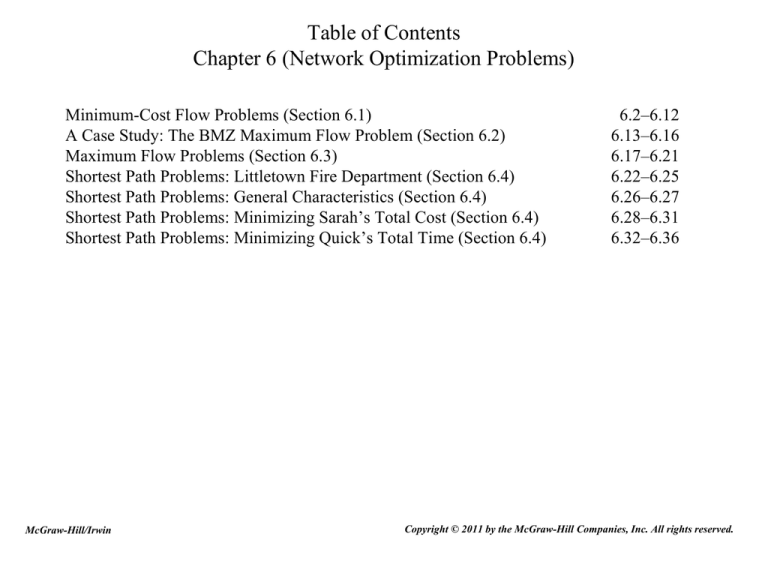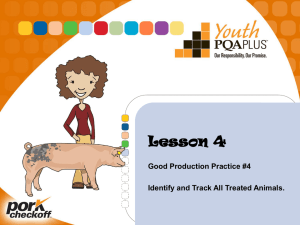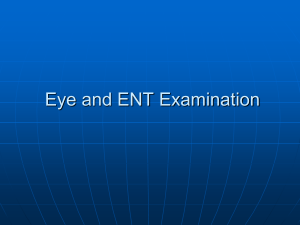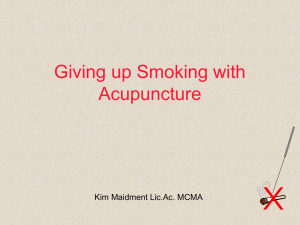
Table of Contents
Chapter 6 (Network Optimization Problems)
Minimum-Cost Flow Problems (Section 6.1)
A Case Study: The BMZ Maximum Flow Problem (Section 6.2)
Maximum Flow Problems (Section 6.3)
Shortest Path Problems: Littletown Fire Department (Section 6.4)
Shortest Path Problems: General Characteristics (Section 6.4)
Shortest Path Problems: Minimizing Sarah’s Total Cost (Section 6.4)
Shortest Path Problems: Minimizing Quick’s Total Time (Section 6.4)
McGraw-Hill/Irwin
6.2–6.12
6.13–6.16
6.17–6.21
6.22–6.25
6.26–6.27
6.28–6.31
6.32–6.36
Copyright © 2011 by the McGraw-Hill Companies, Inc. All rights reserved.
Distribution Unlimited Co. Problem
•
The Distribution Unlimited Co. has two factories producing a product that
needs to be shipped to two warehouses
–
–
–
–
Factory 1 produces 80 units.
Factory 2 produces 70 units.
Warehouse 1 needs 60 units.
Warehouse 2 needs 90 units.
•
There are rail links directly from Factory 1 to Warehouse 1 and Factory 2 to
Warehouse 2.
•
Independent truckers are available to ship up to 50 units from each factory to
the distribution center, and then 50 units from the distribution center to each
warehouse.
Question: How many units (truckloads) should be shipped along each
shipping lane?
6-2
The Distribution Network
80 units
produced
W1 60 units
needed
F1
DC
70 units
produced
F2
W2
90 units
needed
6-3
Data for Distribution Network
6-4
A Network Model
6-5
The Optimal Solution
[80]
[- 60]
(30)
F1
(50)
W1
(30)
[0]
DC
(30)
F2
[70]
(50)
(40)
W2
[- 90]
6-6
Terminology for Minimum-Cost Flow Problems
1. The model for any minimum-cost flow problem is represented by a network
with flow passing through it.
2. The circles in the network are called nodes.
3. Each node where the net amount of flow generated (outflow minus inflow) is a
fixed positive number is a supply node.
4. Each node where the net amount of flow generated is a fixed negative number
is a demand node.
5. Any node where the net amount of flow generated is fixed at zero is a
transshipment node. Having the amount of flow out of the node equal the
amount of flow into the node is referred to as conservation of flow.
6. The arrows in the network are called arcs.
7. The maximum amount of flow allowed through an arc is referred to as the
capacity of that arc.
6-7
Assumptions of a Minimum-Cost Flow Problem
1. At least one of the nodes is a supply node.
2. At least one of the other nodes is a demand node.
3. All the remaining nodes are transshipment nodes.
4. Flow through an arc is only allowed in the direction indicated by the
arrowhead, where the maximum amount of flow is given by the capacity of
that arc. (If flow can occur in both directions, this would be represented by a
pair of arcs pointing in opposite directions.)
5. The network has enough arcs with sufficient capacity to enable all the flow
generated at the supply nodes to reach all the demand nodes.
6. The cost of the flow through each arc is proportional to the amount of that
flow, where the cost per unit flow is known.
7. The objective is to minimize the total cost of sending the available supply
through the network to satisfy the given demand. (An alternative objective is
to maximize the total profit from doing this.)
6-8
Properties of Minimum-Cost Flow Problems
•
The Feasible Solutions Property: Under the previous assumptions, a
minimum-cost flow problem will have feasible solutions if and only if the sum
of the supplies from its supply nodes equals the sum of the demands at its
demand nodes.
•
The Integer Solutions Property: As long as all the supplies, demands, and
arc capacities have integer values, any minimum-cost flow problem with
feasible solutions is guaranteed to have an optimal solution with integer values
for all its flow quantities.
6-9
Spreadsheet Model
3
4
5
6
7
8
9
10
11
B
C
D
From
F1
F1
DC
DC
F2
F2
To
W1
DC
W1
W2
DC
W2
Ship
30
50
30
50
30
40
Total Cost
$110,000
E
<=
<=
<=
<=
F
G
Capacity
Unit Cost
$700
$300
$200
$400
$400
$900
50
50
50
50
H
I
J
Nodes Net Flow
F1
80
F2
70
DC
0
W1
-60
W2
-90
K
L
=
=
=
=
=
Supply/Demand
80
70
0
-60
-90
J
3
4
5
6
7
8
Net Flow
=SUMIF(From,I4,Ship)-SUMIF(To,I4,Ship)
=SUMIF(From,I5,Ship)-SUMIF(To,I5,Ship)
=SUMIF(From,I6,Ship)-SUMIF(To,I6,Ship)
=SUMIF(From,I7,Ship)-SUMIF(To,I7,Ship)
=SUMIF(From,I8,Ship)-SUMIF(To,I8,Ship)
6-10
The SUMIF Function
•
The SUMIF formula can be used to simplify the node flow constraints.
=SUMIF(Range A, x, Range B)
•
For each quantity in (Range A) that equals x, SUMIF sums the corresponding
entries in (Range B).
•
The net outflow (flow out – flow in) from node x is then
=SUMIF(“From labels”, x, “Flow”) – SUMIF(“To labels”, x, “Flow”)
6-11
Typical Applications of Minimum-Cost Flow Problems
Kind of
Application
Supply
Nodes
Transshipment
Nodes
Demand
Nodes
Operation of a
distribution network
Sources of goods
Intermediate storage
facilities
Customers
Solid waste
management
Sources of solid
waste
Processing facilities
Landfill locations
Operation of a
supply network
Vendors
Intermediate
warehouses
Processing facilities
Coordinating product
Plants
mixes at plants
Production of a
specific product
Market for a specific
product
Cash flow
management
Short-term
investment options
Needs for cash at a
specific time
Sources of cash at a
specific time
6-12
The BMZ Maximum Flow Problem
•
The BMZ Company is a European manufacturer of luxury automobiles. Its
exports to the United States are particularly important.
•
BMZ cars are becoming especially popular in California, so it is particularly
important to keep the Los Angeles center well supplied with replacement parts
for repairing these cars.
•
BMZ needs to execute a plan quickly for shipping as much as possible from
the main factory in Stuttgart, Germany to the distribution center in Los
Angeles over the next month.
•
The limiting factor on how much can be shipped is the limited capacity of the
company’s distribution network.
Question: How many units should be sent through each shipping lane to
maximize the total units flowing from Stuttgart to Los Angeles?
6-13
The BMZ Distribution Network
[60 unit s max.]
RO Rotte rdam
[50 unit s max.]
Ne w York NY
[80 unit s max.]
Ne w O rl e an s
LA
Los An gel e s
[70 unit s max]NO
{40 units max.]
ST S tu ttgart
[70 unit s max.]
Borde au x
[40 unit s max.]
BO
[50 unit s max.]
LI
Lis bon
[30 unit s max.]
6-14
A Network Model for BMZ
RO
[60]
[50]
NY
[80]
[40]
BO
LA
[70]
ST
[50]
[70]
NO
[40]
[30]
LI
6-15
Spreadsheet Model for BMZ
3
4
5
6
7
8
9
10
11
12
13
14
B
C
D
From
Stuttgart
Stuttgart
Stuttgart
Rotterdam
Bordeaux
Bordeaux
Lisbon
New Y ork
New Orleans
To
Rotterdam
Bordeaux
Lisbon
New Y ork
New Y ork
New Orleans
New Orleans
Los Angeles
Los Angeles
Ship
50
70
30
50
30
40
30
80
70
Maximum Flow
150
E
F
<=
<=
<=
<=
<=
<=
<=
<=
<=
Capacity
50
70
40
60
40
50
30
80
70
G
H
I
Nodes
Stuttgart
Rotterdam
Bordeaux
Lisbon
New Y ork
New Orleans
Los Angeles
Net Flow
150
0
0
0
0
0
-150
J
K
Supply/Demand
=
=
=
=
=
0
0
0
0
0
6-16
Assumptions of Maximum Flow Problems
1. All flow through the network originates at one node, called the source, and
terminates at one other node, called the sink. (The source and sink in the BMZ
problem are the factory and the distribution center, respectively.)
2. All the remaining nodes are transshipment nodes.
3. Flow through an arc is only allowed in the direction indicated by the
arrowhead, where the maximum amount of flow is given by the capacity of
that arc. At the source, all arcs point away from the node. At the sink, all arcs
point into the node.
4. The objective is to maximize the total amount of flow from the source to the
sink. This amount is measured in either of two equivalent ways, namely, either
the amount leaving the source or the amount entering the sink.
6-17
BMZ with Multiple Supply and Demand Points
•
BMZ has a second, smaller factory in Berlin.
•
The distribution center in Seattle has the capability of supplying parts to the
customers of the distribution center in Los Angeles when shortages occur at
the latter center.
Question: How many units should be sent through each shipping lane to
maximize the total units flowing from Stuttgart and Berlin to Los Angeles
and Seattle?
6-18
Network Model for The Expanded BMZ Problem
HA
[40]
[60]
BN
[30]
[20]
RO
SE
[40]
BE
[60]
[10]
LA
[20]
[50]
NY
[40]
[80]
BO
[70]
ST
[50]
[70]
NO
[40]
[30]
LI
6-19
Spreadsheet Model
3
4
5
6
7
8
9
10
11
12
13
14
15
16
17
18
19
20
21
B
C
D
From
Stuttgart
Stuttgart
Stuttgart
Berlin
Berlin
Rotterdam
Bordeaux
Bordeaux
Lisbon
Hamburg
Hamburg
New Orleans
New Y ork
New Y ork
Boston
Boston
To
Rotterdam
Bordeaux
Lisbon
Rotterdam
Hamburg
New Y ork
New Y ork
New Orleans
New Orleans
New Y ork
Boston
Los Angeles
Los Angeles
Seattle
Los Angeles
Seattle
Ship
40
70
30
20
60
60
30
40
30
30
30
70
80
40
10
20
Maximum Flow
220
E
F
<=
<=
<=
<=
<=
<=
<=
<=
<=
<=
<=
<=
<=
<=
<=
<=
Capacity
50
70
40
20
60
60
40
50
30
30
40
70
80
40
10
20
G
H
I
Nodes
Stuttgart
Berlin
Hamburg
Rotterdam
Bordeaux
Lisbon
Boston
New Y ork
New Orleans
Los Angeles
Seattle
Net Flow
140
80
0
0
0
0
0
0
0
-160
-60
J
K
Supply/Demand
=
=
=
=
=
=
=
0
0
0
0
0
0
0
6-20
Some Applications of Maximum Flow Problems
1. Maximize the flow through a distribution network, as for BMZ.
2. Maximize the flow through a company’s supply network from its vendors to
its processing facilities.
3. Maximize the flow of oil through a system of pipelines.
4. Maximize the flow of water through a system of aqueducts.
5. Maximize the flow of vehicles through a transportation network.
6-21
Littletown Fire Department
•
Littletown is a small town in a rural area.
•
Its fire department serves a relatively large geographical area that includes
many farming communities.
•
Since there are numerous roads throughout the area, many possible routes may
be available for traveling to any given farming community.
Question: Which route from the fire station to a certain farming community
minimizes the total number of miles?
6-22
The Littletown Road System
8
6
A
1
3
6
Fire
Station
4
2
C
D
6
7
6
3
3
B
5
4
4
F
Farming
Communit y
G
5
E
2
4
H
7
6-23
The Network Representation
A
3
(Origin)
O
1
6
4
B
6
4
5
2
D
3
E
7
C
8
F
3
6
5
4
G
2
4
6
T
(Destinat ion)
7
H
6-24
Spreadsheet Model
3
4
5
6
7
8
9
10
11
12
13
14
15
16
17
18
19
20
21
22
23
24
25
26
27
28
29
B
C
D
From
Fire St.
Fire St.
Fire St.
A
A
B
B
B
B
C
C
D
D
E
E
E
E
F
F
G
G
G
H
H
To
A
B
C
B
D
A
C
D
E
B
E
E
F
D
F
G
H
G
Farm Com.
F
H
Farm Com.
G
Farm Com.
On Route
1
0
0
1
0
0
0
0
1
0
0
0
0
0
1
0
0
0
1
0
0
0
0
0
Total Distance
19
E
F
Distance
3
6
4
1
6
1
2
4
5
2
7
3
8
3
6
5
4
3
4
3
2
6
2
7
G
H
I
Nodes
Fire St.
A
B
C
D
E
F
G
H
Farm Com.
Net Flow
1
0
0
0
0
0
0
0
0
-1
J
K
=
=
=
=
=
=
=
=
=
=
Supply/Demand
1
0
0
0
0
0
0
0
0
-1
6-25
Assumptions of a Shortest Path Problem
1. You need to choose a path through the network that starts at a certain node,
called the origin, and ends at another certain node, called the destination.
2. The lines connecting certain pairs of nodes commonly are links (which allow
travel in either direction), although arcs (which only permit travel in one
direction) also are allowed.
3. Associated with each link (or arc) is a nonnegative number called its length.
(Be aware that the drawing of each link in the network typically makes no
effort to show its true length other than giving the correct number next to the
link.)
4. The objective is to find the shortest path (the path with the minimum total
length) from the origin to the destination.
6-26
Applications of Shortest Path Problems
1. Minimize the total distance traveled.
2. Minimize the total cost of a sequence of activities.
3. Minimize the total time of a sequence of activities.
6-27
Minimizing Total Cost: Sarah’s Car Fund
•
Sarah has just graduated from high school.
•
As a graduation present, her parents have given her a car fund of $21,000 to
help purchase and maintain a three-year-old used car for college.
•
Since operating and maintenance costs go up rapidly as the car ages, Sarah
may trade in her car on another three-year-old car one or more times during
the next three summers if it will minimize her total net cost. (At the end of the
four years of college, her parents will trade in the current used car on a new car
for Sarah.)
Question: When should Sarah trade in her car (if at all) during the next three
summers?
6-28
Sarah’s Cost Data
Operating and Maintenance Costs
for Ownership Year
Trade-in Value at End
of Ownership Year
Purchase
Price
1
2
3
4
1
2
3
4
$12,000
$2,000
$3,000
$4,500
$6,500
$8,500
$6,500
$4,500
$3,000
6-29
Shortest Path Formulation
25,000
17,000
10,500
10,500
(Origin) 0
5,500
1
5,500
2
5,500
3
5,500
4
(Destinat ion)
10,500
17,000
6-30
Spreadsheet Model
B
3
4
5
6
7
8
9
10
11
12
13
14
15
16
17
18
19
20
21
22
23
Y ear
Y ear
Y ear
Y ear
1
2
3
4
From
Y ear 0
Y ear 0
Y ear 0
Y ear 0
Y ear 1
Y ear 1
Y ear 1
Y ear 2
Y ear 2
Y ear 3
C
D
E
Operating &
Maint. Cost
$2,000
$3,000
$4,500
$6,500
Trade-in Value
at End of Y ear
$8,500
$6,500
$4,500
$3,000
Purchase
Price
$12,000
On Route
0
1
0
0
0
0
0
0
1
0
Cost
$5,500
$10,500
$17,000
$25,000
$5,500
$10,500
$17,000
$5,500
$10,500
$5,500
To
Y ear
Y ear
Y ear
Y ear
Y ear
Y ear
Y ear
Y ear
Y ear
Y ear
1
2
3
4
2
3
4
3
4
4
Total Cost
F
G
H
Nodes Net Flow
Y ear 0
1
Y ear 1
0
Y ear 2
0
Y ear 3
0
Y ear 4
-1
I
J
=
=
=
=
=
Supply/Demand
1
0
0
0
-1
$21,000
6-31
Minimizing Total Time: Quick Company
•
The Quick Company has learned that a competitor is planning to come out
with a new kind of product with great sales potential.
•
Quick has been working on a similar product that had been scheduled to come
to market in 20 months.
•
Quick’s management wishes to rush the product out to meet the competition.
•
Each of four remaining phases can be conducted at a normal pace, at a priority
pace, or at crash level to expedite completion. However, the normal pace has
been ruled out as too slow for the last three phases.
•
$30 million is available for all four phases.
Question: At what pace should each of the four phases be conducted?
6-32
Time and Cost of the Four Phases
Remaining
Research
Development
Design of
Mfg. System
Initiate Production
and Distribution
Normal
5 months
—
—
—
Priority
4 months
3 months
5 months
2 months
Crash
2 months
2 months
3 months
1 month
Level
Remaining
Research
Development
Design of
Mfg. System
Initiate Production
and Distribution
Normal
$3 million
—
—
—
Priority
6 million
$6 million
$9 million
$3 million
Crash
9 million
9 million
12 million
6 million
Level
6-33
Shortest Path Formulation
,
0
1 h)
as
r
(C
2
5
3 ty) 2, 21(Priorit y)3, 12(Priorit y)4, 9
o ri
i
(C 3
r
P
(
ras
1, 27 2
h)
( Cr
a
s h)
2
5
5 al)
4, 6
2,
18
3,
9
m
)
(Priorit
y)
r
(Priorit
y)
y
t
o
3
i
r
(C 3
(N
io
r as
(Origin) 0, 30 4
1, 24 (Pr
(Priorit y) (C 2
h)
(C 2
ra
2
s h 2, 15 5
ra s
4, 3
3,
6
)
h)
(Priorit
y)
((P
riority)
3 ri ty ) (C 3
ras
1, 21 ri o
h)
(Cr (P2
ash
5
3, 3 2
4, 0
) 2, 12(Priorit
y)
(Priorit y)
0
ra
1 h)
s
(C
0
T
(Destinat ion)
1 s h)
ra
(C
0
6-34
Spreadsheet Model
3
4
5
6
7
8
9
10
11
12
13
14
15
16
17
18
19
20
21
22
23
24
25
26
27
28
29
30
31
32
B
C
D
From
(0, 30)
(0, 30)
(0, 30)
(1, 27)
(1, 27)
(1, 24)
(1, 24)
(1, 21)
(1, 21)
(2, 21)
(2, 21)
(2, 18)
(2, 18)
(2, 15)
(2, 15)
(2, 12)
(3, 12)
(3, 12)
(3, 9)
(3, 9)
(3, 6)
(3, 6)
(3, 3)
(4, 9)
(4, 6)
(4, 3)
(4, 0)
To
(1, 27)
(1, 24)
(1, 21)
(2, 21)
(2, 18)
(2, 18)
(2, 15)
(2, 15)
(2, 12)
(3, 12)
(3, 9)
(3, 9)
(3, 6)
(3, 6)
(3, 3)
(3, 3)
(4, 9)
(4, 6)
(4, 6)
(4, 3)
(4, 3)
(4, 0)
(4, 0)
(T)
(T)
(T)
(T)
On Route
0
0
1
0
0
0
0
1
0
0
0
0
0
0
1
0
0
0
0
0
0
0
1
0
0
0
1
Total Time
10
E
F
Time
5
4
2
3
2
3
2
3
2
5
3
5
3
5
3
5
2
1
2
1
2
1
2
0
0
0
0
G
H
I
J
K
Nodes
(0, 30)
(1, 27)
(1, 24)
(1, 21)
(2, 21)
(2, 18)
(2, 15)
(2, 12)
(3, 12)
(3, 9)
(3, 6)
(3, 3)
(4, 9)
(4, 6)
(4, 3)
(4, 0)
(T)
Net Flow
1
0
0
0
0
0
0
0
0
0
0
0
0
0
0
0
-1
=
=
=
=
=
=
=
=
=
=
=
=
=
=
=
=
=
Supply/Demand
1
0
0
0
0
0
0
0
0
0
0
0
0
0
0
0
-1
6-35
The Optimal Solution
Phase
Level
Time
Cost
Remaining research
Crash
2 months
$9 million
Priority
3 months
6 million
Crash
3 months
12 million
Priority
2 months
3 million
10 months
$30 million
Development
Design of manufacturing system
Initiate production and distribution
Total
6-36







